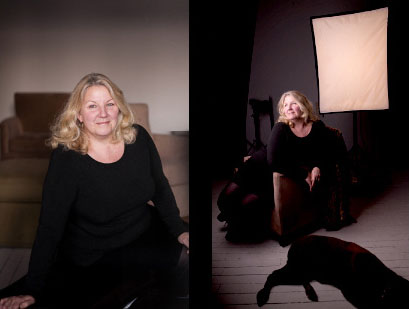 SUSAN MIKULA
SUSAN MIKULA
art, inspiration and heart
a must see

photo: Paul Teeling
American Device: recent photographs, by Susan Mikula
George Lawson Gallery, room for painting room for paper
49 Geary St. 2nd Floor
San Francisco, CA 94108
Tel: 415.772.0977
Hours: Tues – Sat 11:00 – 5:30
Show runs from 2.25.10 – 3.27.10
Opening reception 2.25.10, 5:30 to 7:30 PM
Susan Mikula is coming to San Francisco with a new body of work, sharing her unique and meaningful photographic expressions with the bay area. All I can say is that Susan Mikula and Rachel Maddow are one dynamite couple with a an ideal balance of art and politics. They both shine in their careers and we’re here to tell you a little bit more about this dynamic artist, her process and why you will be sorry if you miss her exhibition while it resides in San Francisco.
Susan’s photos seem to bring an element of enigma to the subject and there are a lot of variables that motivate her to take a photograph. One thing that makes Susan feel like she wants to work with something as a subject, and take pictures of it, is seeing something submerged in the water. There are a lot of old piers on the west side of New York. When she sees the old pilings just below the height of the water when the tide has come in just so on the Hudson River, that is what she wants to bring to the photograph. She has likely seen this 1000 times but she is moved every single time. It’s a feeling for Susan and this is how she sees the world. Susan’s photographs are heavily associated with a well thought out process mixed with this type of feeling and a touch of ” I feel like how I get to see things is a gift to me..”
So essentially, Susan is trying to re-create this effect in her work, whatever the photographic version of it is to make that experience and feeling happen for the rest of the world.
In her upcoming exhibition there are no people which is a huge departure from her earlier Nine Portraits exhibition.
SUSAN: I did those nine portraits and that was really hard for me. First of all a portrait is different than a model. I have had some nude models in my early work, never with a face and only with people who I was paying as models, so that’s very different. You don’t have the same responsibility to a model because a model is someone that you’re using for your own ideas.
When I was working on those portraits I really felt a responsibility to get some of that person into the work and treat them like a person. I know that sounds ridiculous but I look at this differently. This person is going to come through in this picture if I do it right. That was the most difficult thing I’ve ever tried to do. It was difficult working with other humans who you like so much, and you get along, who are being extremely kind to you about allowing you to take pictures of them. I found that much harder because of the human element but it was really worth it. That’s why I think that portraiture seems so hard for me in general. That responsibility.
I know that everyone laughs about it but that’s the thing that people thought at the beginning of photography. I’m so grabbed by that. For example August Sander, who was photographing ordinary people in what I think were extraordinary ways. All of those people would be dead right now and I look at those photos and think ‘these people are still right here in these portraits.’ That’s how good they are. You look at something like that and you think right, ok, that’s what’s happening here. There’s some little piece of each person.
ARTGIRL: So is this something that you’re saying scares or intimidates you?
SUSAN: Yes, from the end of being photographed, but also the responsibility of taking them. So anyway, that’s maybe more than you wanted to know. (laughing)
ARTGIRL: I want to know it all! It sounds like there’s a lot of thought and planning that goes into all of your pieces, like you have to visualize it before you ever take that photo.
SUSAN: I do. I’m very slow. There’s no other way to put it. I think about it. I think about it for a very long time and in my thinking about it I mostly think about it not as a specific piece so much as what I want the overall… not final result to be, but how it will feel. I think about that for a very long time. I also think about the mechanics of it. What kind of camera I would use. What kind of film, all those things, and then when it’s time to take the pictures it happens fast. But prior to that it’s very thought out.
ARTGIRL: I understand that you are using a pinhole camera for this show, with discontinued film?
SUSAN: Yes, discontinued, expired monochromatic film for this show. The decision was based on what format I want and what I want that format to do. So that was an easy decision, but it meant buying film online.
ARTGIRL: Isn’t it hit and miss with that? You never know if the film will work out or not!
SUSAN: That’s true. The main thing with expired Polaroid film is that you may not have peel apart film. You may not be able to peel the piece apart without removing some of the developer and you can get a white spot on the picture – but that’s the biggest chance you’re taking, that you’re going to wreck them that way. But I know other possibilities and things that can go wrong. I’ve used expired film before and I know the chemicals and how it’s going to turn and sometimes that’s a plus.
ARTGIRL: So what happens when you can’t get that medium anymore?
SUSAN: I actually have an idea. It really made me ask myself what is the appeal of the Polaroid that I can’t live without, and it occurred to me that it has something to do with there being a great democratization of photography. It was the second time that unique-positive photography was made widely available to ordinary people. The first was with tintype photography. So I’m actually learning wet plate collodion photography and hopefully my Polaroid film will hold out until I actually learn how to do that!
ARTGIRL: So you have a plan!
SUSAN: I do! It’s a crazy plan to go backward in time, not forward! I’m going to hope to be a tintype artist in my next incarnation.
ARTGIRL: Do you have any art on your walls?
SUSAN: I do. I really love art. I really do. I love paintings but I do not paint. It’s like such a mystery, magical, and I have some paintings around and really believe in supporting living artists. For example, this year we bought two really great paintings – “untitled” by Denny Camino and “little girl from little rock” by Maggie Mailer. It’s really important to me, so if I can put any money together, that’s what I do. I also have photographs, a small collection that is in my waking spot. You know, the very first spot in the morning when you wake up that your eyes go.
ARTGIRL: I love that. “Waking spot.”
SUSAN: I’m sure I didn’t make that up, but I have Sally Mann’s “Last Light” in my waking spot that I bought so long ago, almost 20 years ago, and I have a couple of other artists’ work including Paul Teeling, whose color work I love very much.
ARTGIRL: Are there any other places where you surround yourself with art?
SUSAN: Museums are my happy place when I’m feeling out of place. I go to see my favorite things in the galleries in New York. It’s like visiting with friends. I love to be able to do that.
ARTGIRL: How has your shift been from the rural to urban environment?
SUSAN: That’s been a big change for me. I think it has opened up my being and given me more, partly because the city is so rich in visuals and there’s always something new, even if it’s a paper bag blowing down the street. There might be some new fantastic thing that somebody’s done. There’s street art in NY that the artists don’t have any idea if anyone will see it – or they know for a fact that it will only be up until the street sweeper goes by. I really love that and I think I’ve gotten a lot out of that.
ARTGIRL: How sound proof is your home?
SUSAN: We’re not very sound proof at all. We live near bars that close at 5 in the morning. I’m not used to it yet. That’s still a work in progress.
ARTGIRL: Do you listen to music while you work?
SUSAN: I don’t listen to music while I work. Music is just fun while I relax. I would not be able to focus.
ARTGIRL: What would you be listening to?
SUSAN: Rachel and I have similar musical tastes. Obviously no one is the same but we listen to lots of what I call kind of alternative mainstream. To me they’re mainstream, because all my friends listen to them, but I know that it’s not what you can hear on the radio most of the time. But we listen to Cat Power, that level of listening. We both like the music very much but I also like Billie Holiday. That’s part of my own relaxing genre. Right now, on the CD player, we have Lucero, Deer Tick, Ella Fitzgerald, Thad Cockrell, Bob Dylan, Chet Baker… Do you know Erin McKeown’s work?
ARTGIRL: Yes I do!
SUSAN: I like her stuff a lot too and think she’s doing fantastic things. I really like that kind of music and her demeanor onstage in other things I’ve seen her do. She’s fantastic, and that kind of work, that singer/songwriter work, I like very much.
ARTGIRL: This has been such a great look into who you are and how your artwork evolves.
SUSAN: The point for me, when I read interviews about artists, is that I’m happy to learn more about them to add to my experience of their work. It makes it fresh and I think it’s nice for everyone. That’s what I look for. I have favorite artists like everybody else, so it’s nice for me to read something personal about them.
We thank Susan for taking so much time to give us this insight to her life and her art so that we could read something personal about the artist and the woman behind the lens.- ggygo
